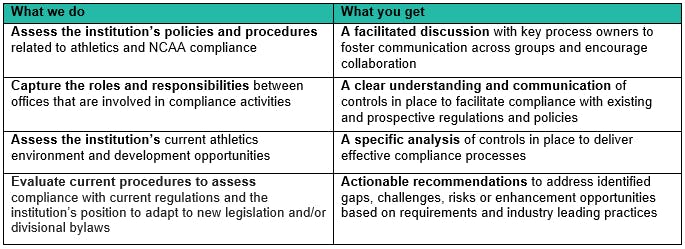
What does name, image and likeness look like one year later?
A year ago, effective July 1, 2021, all three divisions of the National Collegiate Athletic Association (NCAA) adopted an interim policy suspending preexisting name, image, and likeness (NIL) rules. While there is currently no federal law governing NIL, legislation has passed in more than half of the states.
In the past twelve months, student athletes, businesses and higher education institutions have played a role in the evolution of NIL, but at what cost?
Student athletes
Student athletes are now able to profit from the use of their NIL without jeopardizing their eligibility to compete at the NCAA level. According to data published by Opendorse, a collegiate athletics technology company, most student athletes cashing in on their NIL are doing so by posting content on social media. Using social media, student athletes have become influencers and spokespeople for small businesses, national brands and even politicians.
While additional income earned through NIL opportunities may be helpful, athletes must consider the impact these earnings may have on their federal financial aid packages as well as federal and state tax bills. These are not topics with which student athletes are often very familiar. According to the NCAA’s Fall 2021 Student-Athlete Well-Being Survey, when planning for the future, student athletes indicated a need for educational resources on tax and financial literacy (49%), career planning (47%), navigating NIL opportunities (40%) and professional opportunities in sport (37%).
The focus on NIL opportunities, in addition to the societal pressures and personal traumas that student athletes may be facing, can have an adverse impact on student athlete mental health. NIL deals have the potential to create conflicts between teammates and other priorities (e.g., coursework) and cause additional stress.
Businesses
National brands and smalls businesses have recently had great success with influencer marketing, where businesses compensate individuals for posting about a product or service on social media. Generally, successful student athletes have a large social network and engaging media platforms. Pairing that fame with their partnered company’s and marketing efforts can extend to a broader audience.
While some companies may have experience working with professional athletes, working with collegiate athletes is still a new space for many small businesses and national brands. Certain challenges arise when engaging with student athletes. For example, there are rules and regulations imposed by the NCAA, state and/or student athlete’s institution that may restrict or limit the types of deals that can be entered. As the regulations continue to evolve, businesses assume risk when partnering with student athletes, including reputational damage that could result from how individuals represent themselves.
Colleges and universities
One year after NIL regulations took effect, colleges and universities continue to grow more sophisticated in how they approach NIL and the related risks.
Current challenges and considerations
- Institutions may use their NIL policies to their advantage but the degree to which these policies can be leveraged for recruiting purposes has limitations. The NCAA’s interim NIL policy upholds prohibitions on pay-for-play and impermissible recruiting inducements and does not allow NIL compensation contingent on enrollment at a particular institution. However, the limited guidance from state regulations and the NCAA’s interim policy leaves much of the NIL landscape up for interpretation.
- A student athlete may agree to terms and conditions that are not permitted within state laws and/or NCAA guidance, but it is not always clear who should be held accountable or what the institution’s role is, if any, in protecting its athletes from impermissible or unfavorable agreements. To mitigate risks associated with non-compliance, some institutions have charged their athletic departments or a third-party provider with reviewing NIL agreements offered to the student athletes before they are executed.
- A student athlete may agree to terms and conditions that are not permitted per institutional and/or conference policies. However, an institution may not have the resources to effectively and efficiently review agreements disclosed in accordance with its own policies.
The NCAA has started to investigate instances in which NIL benefits may violate association rules. Could your institution’s approach to NIL stand up to an investigation? Is your college or university balancing NIL opportunities and risks to best serve your institution and its student athletes?
Overall, student athletes, businesses and institutions all have the opportunity to benefit from the current NIL landscape, but each party has a unique set of risks to address and manage as well.
Baker Tilly can help
We can help your institution take a proactive approach to evaluate the current state of your NIL policies and processes and athletic department internal controls to identify opportunities that align with enhancing the student athlete experience and complying with potential legislative changes.
For more information, or to learn more about how Baker Tilly’s collegiate athletics specialists can help your institution and its student athletes navigate NIL opportunities and risks, contact our team.

